
Tepe Zargaran, Corinthian Capital, Kabul Museum, Afghanistan.
The combined results of researchers at the University of Chicago utilizing satellite imaging along with French and Afghan archaeologists and others on the ground confirm that there has been systematic looting of dozens of archaeological sites in Afghanistan using heavy machinery that has destroyed entire ancient settlements. Looting patterns show whole sites scraped clean by bulldozers in hopes of finding increasingly elusive rich caches; in effect, civilizations are being demolished for scraps.
Archaeologists who worked at the end of the U.S. occupation of Afghanistan say that under the Taliban and local commanders, use of heavy machinery has replaced the opportunistic local looting by locals armed with picks and shovels prevalent during the previous Ghani government.
Professor Gil Stein, director of the University of Chicago’s Center for Cultural Heritage Preservation said that the Center has documented the existence of over 29,000 archaeological sites across Afghanistan. He noted that distinctive marks left by massive bulldozers can now be seen in imaging of Late Bronze Age and Iron Age sites, especially in northern Afghanistan in the region around Balkh, where many artistically rich centers for trade along the ancient Lapis Route are located. These later images show many areas reduced by bulldozing, then riddled with pits dug by looters. The research team’s findings reveal a harrowing reality, with 162 ancient settlements reportedly devastated at an alarming rate of one per week between 2018 and 2021. They say the pattern of destruction commenced under the previous government led by former President Ashraf Ghani, but the weakness of Ghani’s government, coupled with its limited control over certain regions of the country, complicates efforts to pinpoint the start of such actions and culpability for the current losses.
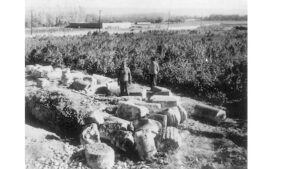
Cannabis for hashish production growing near archaeological site near Balkh, Afghanistan. DAFA.
Despite the Taliban’s early rhetoric about its determination to preserve archaeological remains, the use of heavy equipment to demolish stupas and take down mounds covering walled settlements has continued at at least 37 sites since the Taliban’s resurgence. The region of ancient Balkh, which encompasses the largest city in northern Afghanistan, Mazar-i-Sharif, was among the initial territories seized by the Taliban prior to their capture of the capital Kabul in August 2021 and has arguably suffered the worst and most extensive damage.
A presentation on current looting by archaeologist Philippe Marquis, director at the French Archaeological Delegation in Afghanistan (DAFA) was hosted by professor Stephane Ipert of the American University of Afghanistan and director of the Heritage Library in Qatar National Library in March 2024. According to Marquis, traditional methods of opportunistic digging in northern Afghanistan have changed to purposeful destruction of entire sites using heavy machinery. Such systematic exploitation of sites and destructive methods of excavation threatens to erase centuries of history buried beneath the soil.

Map of Tepe Zargaran Aga Khan Cultural Services Afghanistan.
Marquis described the looting economy as a hierarchy involving a chain of intermediaries. At the first level are members of local communities collecting antiquities in the field through ‘salvage’ digging. They know the location of the sites even if they don’t have a precise idea of their historical value. In Afghanistan, such looting has long been a side activity for farmers, taking place sporadically and providing additional revenue in case of poor crops or unexpected financial needs.
Local landowners, goldsmiths, and money lenders, all of whom handle financial matters within the local communities, buy finds or fund operations in exchange for a share of the monetary gains. These intermediaries are able to sell artifacts at prices higher than what the initial collectors receive. They may also have connections to the next level of buyers, located either within Afghanistan or abroad, including in Pakistan, a primary transit country. The export of antiquities is multi-directional: north toward Uzbekistan[1], east to Pakistani tribal territory, and south through Baluchistan into Pakistan and Iran.
Marquis equates the mid-level traders with antiquities professionals who may be skilled in the restoration and appraisal of looted items, assigning them market-based commercial value. He noted that international dealers typically do not have direct contacts with the local looting communities. Historically, he said, until the 1990s, the primary buyers of antiquities were based in Europe and North America. However, in recent decades, the main market has shifted to the Gulf States and other Arab countries, reflecting changes in global demand as Western buyers will not purchase looted items from Afghanistan.
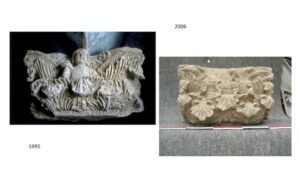
Comparable objects probably from Tepe Zargaran, from market in 1995 and located in 2006 among stones used by villagers to construct an irrigation canal – near Balkh, Afghanistan.
Marquis says that the 1990s was the darkest era of cultural pillage in the region, particularly at a site near Balkh known as Tepe Zargaran, which was looted by rural community members under the oversight of local commanders. Significant finds from this time included sculptural elements from the Kushan period, likely belonging to a Buddhist stupa dating back to the 2nd-3rd century.
In 1995, local farmers had used large stone blocks from a stupa for constructing irrigation channels. Notably, the area immediately surrounding site was used for cultivating cannabis for hashish, long a key agricultural commodity in the region.
When archaeologists were able to return to northern Afghanistan in 2006, archaeologists were able to identify elements of Greek pillars, columns, and decorative elements in monumental architecture used in the construction of the canals that corresponded to objects still present at the site. These marked the first documented finds of such Hellenistic materials in Balkh. A few comparable architectural sculpted elements were then found in the Western market. According to Marquis, being able to reconstruct the site in theory and trace the original locations of looted objects served as a critical method for reducing scientific loss and enhancing understanding of the site’s historical context. It was also an initial step toward potentially restituting some of the decorative materials that had made their way overseas.
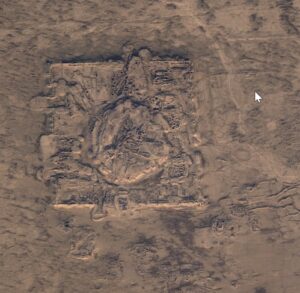
Dashli site showing pockmarked excavation after earthmoving, 2023 Google Earth.
With the establishment of a new government in Afghanistan, official excavations in a number of areas resumed, allowing archaeologists to assess the extent of previous looting. Efforts were intensified to engage local communities in the preservation of their heritage. Involving local residents and providing employment to them was the most effective strategy to curtail further looting. This approach aimed not only to protect the site but also to benefit the local community economically, thereby reducing the incentive for looting.
The most severe destruction has been recorded in the years 2021-2022, marking a devastating period for Afghanistan’s archaeological heritage. A striking example of this new form of looting is visible at the site of Dashli, which was first excavated by Greek-Russian archaeologist Victor Sarianidi in the 1970s. Although there had been only minor disturbances of the site until the 21st century, by 2019, a substantial portion of the site had been removed with bulldozers, and by 2021, nearly all archaeological structures were obliterated. Archaeological techniques were even employed to pinpoint previously undetected structures, exacerbating the damage.

Victor Ivanovich Sarianidi, 23 September 1922 – 22 December 2013, archaeologist, primary discoverer and excavator of the Central Asian Bronze Age civilization.
Development programs are increasingly threatening archaeological sites, with some of the most significant damage being caused by large-scale infrastructure projects. The construction of the Qosh Tepe Canal, which began in 2021-2022, is a major concern. This vast irrigation channel, planned to stretch 250 kilometers, has already seen over 100 kilometers excavated around the Balkh oasis. The canal was initially set to pass directly through a significant archaeological site. Fortunately, following protests, the canal’s route was altered to bypass this site. However, the building of such a large channel poses ongoing risks to numerous archaeological sites across the Balkh region.
Similar impacts have been seen in southern Afghanistan in Sistan province, where an extensive canal has already demonstrated the adverse effects on nearby sites as a result of associated development activities, even if the projects do not directly touch the archaeological sites.
Another looming threat is the development of Mes Aynak, a huge Buddhist archaeological site of outstanding historical and archaeological interest, into a giant copper pit mine by Chinese companies. Additionally, concerns are mounting over a proposed pipeline that will traverse Afghanistan. Although potentially less destructive than a canal, the pipeline is still expected to cause considerable damage to archaeological sites along its route. Urban development around Kabul also seriously threatens both historical and archaeological sites.
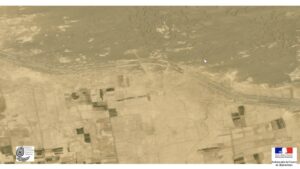
Satellite view of the 285 km long Qosh Tepe Canal, which cuts through Balkh territory replete with archaeological remains. Courtesy Embassy of France and DAFA.
Marquis argued that the severe economic hardship suffered by local communities throughout Afghanistan today could be mitigated by engaging them in legitimate archaeological employment, as the income from looting is only marginally different from other forms of labor they engage in. Despite the diminished capacity and authority of local authorities to combat looting, the most effective strategy to prevent looting remains collaborative efforts to economically support local communities, aligning their interests with the preservation and protection of their archaeological heritage. However, Marquis noted that so far, Afghan authorities have been largely unconcerned, neither halting the looting by bulldozer nor lodging claims for the return of lost artifacts.
There is evidence to suggest that many looted items from Afghanistan are being trafficked from Pakistan to Thailand and subsequently to the United Arab Emirates. Additionally, artifacts are making their way from Thailand to the People’s Republic of China. This new network of trafficking routes highlights how the illicit antiquities trade continues in nations that are not part of the traditional European and US antiquities market, which has repeatedly expressed concerns about destruction in Afghanistan and is unwilling to trade in looted archaeological materials today.
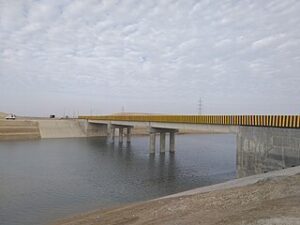
Qoshtepa canal, photo by Bek1998, 13 December 2023, CCA-SA 4.0 International license.
In an interview with the BBC in February 2024, Said Reza Huseini, a research fellow at Cambridge University and a native of Balkh, expressed profound dismay upon seeing the satellite imagery provided by the University of Chicago. “When I hear about it, I feel as if my soul is dying,” he lamented. “No one could conduct excavations or digging activities without the authorization of local strongmen and militias,” he said. “For them, the historical significance holds little importance; they excavate and destroy in pursuit of potential discoveries.” He recounted an incident where he was involved in efforts to secure archaeological access to an ancient site, only to find a militia commander engaging in opium cultivation on the premises.
In 2001, the Taliban shocked the global community when they blew up the 1,500-year-old Bamiyan Buddhas, once the largest standing Buddha statues in the world. Not long after, the U.S. response to 9/11 drove the Taliban from power. When the Taliban returned two decades later, they claimed they would respect the country’s ancient heritage. Atiqullah Azizi, the Taliban’s acting deputy minister for information and culture, has denied allegations of looting, asserting that an 800-strong unit has been tasked with safeguarding historic sites. In the same BBC interview, Azizi acknowledged that some organizations had provided the ministry with images depicting “bulldozer movements and people moving soil,” but he maintained that thorough inspections conducted by various teams found no evidence of looting at any of the sites.
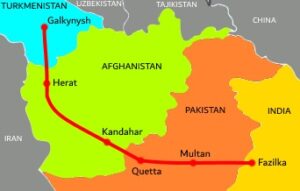
TAPI-EIA, Map of route of Turkmenistan-Afghanistan-Pakistan-India pipeline. Wikipedia, public domain.
Additionally, the Taliban’s defense ministry announced the arrest of three individuals in September 2023, accused of attempting to smuggle antiquities supposedly valued at approximately $27 million. The seized items (which were said to include mummies and a golden crown, both extremely unlikely to have been authentic) were reportedly handed over to the national museum in Kabul.
Mohammad Fahim Rahimi, former director of the National Museum of Afghanistan, well-known for defending the security of the museum in the initial Taliban takeover, spoke briefly during the DAFA program, stating that in recent years, more than 15,000 objects had been confiscated by Afghanistan customs at airports and through border checks. The seized goods had been returned to the National Museum in Kabul.
Professor Stein of the University of Chicago Center for Cultural Heritage Preservation refrained from speculating on the reasons behind the denial of looting claims. However, he emphasized the continuity of looting activities across different political regimes. “The heritage of Afghanistan is truly part of world heritage and something that belongs to all of us,” he said, underscoring the world’s collective responsibility to preserve and safeguard Afghanistan’s cultural legacy.
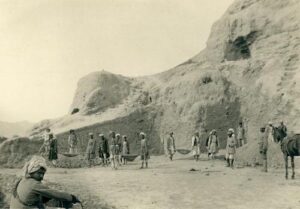
The DAFA has worked in Afghanistan since 1923. Excavation of the Stupa of Top-e Rostam, in Afghanistan, at Balkh. Photograph by Alfred Foucher, 1924. MNAAG, PARIS, DIST./RMN GRAND PALAIS/IMAGE MUSÉE GUIMET
[1] We have not seen a pattern of antiquities traveling through Uzbekistan despite Marquis’ assertion. We know of only one case of antiquities trading among ordinary citizens, as opposed to exploitation by officials, and in this one case, a lengthy prison sentence was imposed for trading in minor, low value items.
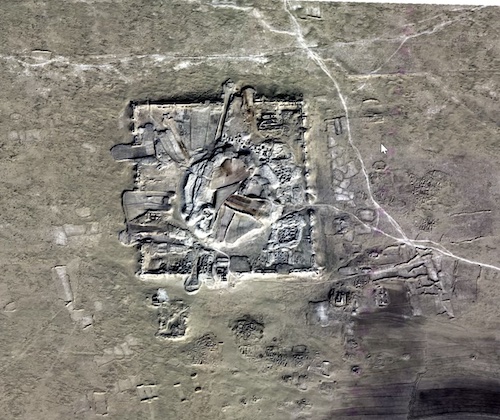 Bronze Age site of Dashli in northern Afghanistan, excavated by archaeologist Victor Sarianidi in 1970s, showing destruction by heavy machinery in 2021. Google Earth.
Bronze Age site of Dashli in northern Afghanistan, excavated by archaeologist Victor Sarianidi in 1970s, showing destruction by heavy machinery in 2021. Google Earth. 

